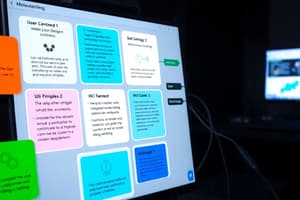Podcast
Questions and Answers
What is the primary focus of user experience (UX) in user interface design?
What is the primary focus of user experience (UX) in user interface design?
- Minimizing costs for the organization
- Understanding users' needs and limitations (correct)
- Maximizing aesthetic appeal
- Enhancing security features
What should a design team consider when crafting a problem statement?
What should a design team consider when crafting a problem statement?
- The aesthetic design preferences
- The latest technology trends
- The objectives of the organization (correct)
- The features of competitor products
Which technique is NOT commonly used for data gathering in UX/UI design?
Which technique is NOT commonly used for data gathering in UX/UI design?
- Social Media Analysis (correct)
- Observation
- Surveys
- Questionnaires
What are trade-offs in design analysis primarily used for?
What are trade-offs in design analysis primarily used for?
Which statement about compression in design is true?
Which statement about compression in design is true?
What is a user scenario in UX/UI design?
What is a user scenario in UX/UI design?
Which of the following is NOT a factor to understand in design analysis?
Which of the following is NOT a factor to understand in design analysis?
What aspect of user interface design considers human error?
What aspect of user interface design considers human error?
What is one of the primary benefits of using paper prototyping?
What is one of the primary benefits of using paper prototyping?
Which element is essential for representing a button in a sketch?
Which element is essential for representing a button in a sketch?
What distinguishes UX design from UI design?
What distinguishes UX design from UI design?
What challenge is associated with using paper prototypes?
What challenge is associated with using paper prototypes?
Which of the following is NOT an advantage of low-level prototyping?
Which of the following is NOT an advantage of low-level prototyping?
What should the search screen of the tourist information system include?
What should the search screen of the tourist information system include?
What is the primary purpose of creating a user scenario?
What is the primary purpose of creating a user scenario?
In designing the interactive system for students and instructors, what is the primary goal of the first screen?
In designing the interactive system for students and instructors, what is the primary goal of the first screen?
Which component should be sketched first when creating a wireframe?
Which component should be sketched first when creating a wireframe?
Which of the following characteristics should the tourist information app's search feature possess?
Which of the following characteristics should the tourist information app's search feature possess?
What is the recommended way to convey hierarchy in text using wireframes?
What is the recommended way to convey hierarchy in text using wireframes?
When sketching a video player in a wireframe, what symbol is typically used?
When sketching a video player in a wireframe, what symbol is typically used?
What should be avoided while creating wireframes, as per the sketching principles?
What should be avoided while creating wireframes, as per the sketching principles?
How can checklist items be represented in a wireframe?
How can checklist items be represented in a wireframe?
What is the appropriate way to depict a form field in a wireframe?
What is the appropriate way to depict a form field in a wireframe?
What technique should be used to indicate where an image will be placed in a wireframe?
What technique should be used to indicate where an image will be placed in a wireframe?
Flashcards
User Interface (UI)
User Interface (UI)
The area where user interaction with machines (like computers, mobile devices) happens.
User Experience (UX)
User Experience (UX)
Understanding users' needs, values, abilities, and limitations, alongside business goals.
Problem Understanding
Problem Understanding
The initial step in design; figuring out the problem to solve and what the organization aims for.
Data Gathering
Data Gathering
Signup and view all the flashcards
Task Analysis
Task Analysis
Signup and view all the flashcards
Design Analysis
Design Analysis
Signup and view all the flashcards
User Scenario
User Scenario
Signup and view all the flashcards
Trade-offs
Trade-offs
Signup and view all the flashcards
Paper Sketches (Low-Fidelity)
Paper Sketches (Low-Fidelity)
Signup and view all the flashcards
Wireframing
Wireframing
Signup and view all the flashcards
General Layout Sketching
General Layout Sketching
Signup and view all the flashcards
Largest Element First
Largest Element First
Signup and view all the flashcards
Gray Tones (No Color)
Gray Tones (No Color)
Signup and view all the flashcards
Placeholder Images (X)
Placeholder Images (X)
Signup and view all the flashcards
Text Line Sketching
Text Line Sketching
Signup and view all the flashcards
Form Field Representation
Form Field Representation
Signup and view all the flashcards
Button Design
Button Design
Signup and view all the flashcards
Search Bar
Search Bar
Signup and view all the flashcards
Paper Prototyping
Paper Prototyping
Signup and view all the flashcards
UX Design
UX Design
Signup and view all the flashcards
UI Design
UI Design
Signup and view all the flashcards
Tourist App Search
Tourist App Search
Signup and view all the flashcards
Faculty Website Redesign
Faculty Website Redesign
Signup and view all the flashcards
Login Screen
Login Screen
Signup and view all the flashcards
Study Notes
User Interface Design (UX/UI)
- User interface (UI) is the space where interaction between users and machines (like computers, home appliances, mobile devices, and other electronic devices) occurs.
User Interface Design Process
- Understand:
- Understand the problem
- Know organization objectives
- Conduct user research
- Learn about target users and their problems
- Analyze user insights
- Create personas
- Create affinity mapping
- Analyze empathy maps
- Research:
- Conduct user research
- Learn about the target users and their problems
- Analyze:
- Analyze user insights
- Create personas
- Affinity mapping
- Empathy map
- Sketch:
- Create paper representations of solutions
- Prototype:
- Create UI mockups of the solution
- Test:
- Conduct user tests
- Iterate and refine
Step 1: Understand
- The first step is understanding the problem to be solved and the organization's objectives.
- User experience (UX) focuses on understanding users' needs, values, abilities, and limitations.
- UX also considers the business goals and objectives of the project's managing group.
Understanding the Problem
- A design team may develop mobile applications or social networks.
- The problem statement helps navigating decisions and features.
- Should an application use AI?
- What other applications should it link to?
- How should the application's environment be designed?
- A well-defined problem provides a framework for crafting the best solution for users.
Data Gathering Techniques
- Questionnaires:
- Questions can be closed-ended or open-ended.
- Questionnaires can be online.
- Data recording:
- Notes
- Audio recordings
- Video recordings
- Photographs
3-Task Analysis
Design Analysis
- Goals (Purpose): What needs to be achieved?
- Constraints (Materials):
- Understand computer limitations, capacities, tools, and platforms.
- Understand people (psychological, social aspects, and human errors).
- Trade-offs:
- Choosing which goals or constraints can be relaxed to meet other goals.
- Balancing one situation/quality against another to reach an acceptable result.
Example Trade-offs
- Security and Usability Trade-off: A graph shows a negative correlation between security and usability.
- Pencil Trade-off: A diagram compares a poorly designed pencil (wasting graphite) to a better designed one (saving graphite).
- Smartphone Trade-off: A diagram illustrating different phone sizes available on the market.
- Space-time Trade-off: Compressing an image reduces transmission time but may also impact CPU processing time and image quality.
Trade-off Study Matrix
- A matrix used for evaluating different design options against various criteria.
- The matrix assesses various design aspects including performance, cost, mass, quality, volume/size, risk, and durability.
Trade-off Analysis
- Design Question: Is it better to use text or images on a button?
- The analysis considers how well images/text accommodates abstract concepts, their obviousness, visual interest, and accessibility.
4-Sketch (Scenarios)
- A user scenario is a fictitious story of a user accomplishing an action or goal via a product.
- User scenario details what users do with the product and why.
- User scenarios describe steps, interactions, and user thought processes.
Paper Drawings (Low-Fidelity)
Sketching Principles (Wireframing)
- Start from the General Layout: Sketch the outline of each component, explore layout possibilities, and show basic app structure (wireframe).
- Start with the Largest Element: Draw the outline of the largest elements first, then add details.
- Wireframes don't include styling, colour, or graphics.
Basic Elements
- Text lines: Start on the left, have a squiggle, and become straight.
- Body of text: Draws multiple text lines together to form a body of text.
- Headings: Emphasized with bold, larger fonts, underlining, or italicising; used to show hierarchical structure.
- Checklists: Small bullets on the left side of text.
- Images: A rectangle filled with an "X".
- Video player: A rectangle with a right-facing triangle in the middle.
- User profile/avatar: A semicircle at the bottom of a larger circle (representing the body), with a smaller circle on top (representing the head).
- Form field: A skinny horizontal rectangle.
- Buttons: A rectangle, potentially beveled, to improve 3D look.
- Search bar: A magnifying glass in the left corner of a form field.
Note
- There is no right or wrong way to sketch out ideas.
- The quality of the sketch is less important than the ideas conveyed.
Advantages of Paper Prototyping
- Rapid iteration: Easier to discard designs.
- Low cost: Paper is inexpensive.
- Increased creativity: Encourages experimentation and new ideas.
- Team building: Fosters creative environment.
- Documentation: Prototypes serve as excellent documentation.
Disadvantages of Paper Prototyping
- No user reactions: Difficult to gauge whether ideas will work without user feedback.
UX vs UI Sketch
- UX (User Experience): Focuses on aligning user expectations with the product, defining customer needs, and scoping the product.
- UI (User Interface): Focuses on screens, buttons, toggles, icons, and other visual elements.
Exercises
- Tourist information system: Design a mobile application for tourists to search for locations by location name, GPS, or image matching.
- Faculty Website Redesign: Redesign a faculty website to include an interactive system for students to chat with instructors. Includes login and chat screens.
Studying That Suits You
Use AI to generate personalized quizzes and flashcards to suit your learning preferences.




